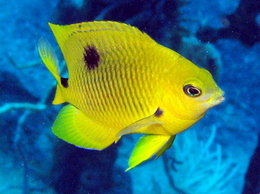Threespot damselfish (Ecology)
Contents
Threespot damselfish
The Threespot damselfish (scientific name: Stegesttes planifrons) is a member of damselfish family (Family Pomacentridae) that lives on coral reefs in the Western Atlantic Ocean and the Caribbean Sea.
|
Scientific Classification Kingdom: Animalia (Animals) |
Physical Description
Adult Threespot damselfish are small (7.5 to 13.0 centimeters long) oval fishes with coloration that varies from yellow brown, to tan, togray. They get their name from three spots on their bodies-the yellow crescent above their eye, the dark spot on the base of their pectoral fin, and a dark spot located on the upper base of the tail. Juvenilesare bright yellow with a black spot on the base of the tail and a large black spot on the upper back and dorsal fins.
Distribution
This species is found in the tropical Western Atlantic including southern Florida (USA), Bahamas and the Caribbean Sea.
Habitat
Threespot damselfish live among coral reef systems at depths ranging fromoneto 30 meters. They are typically found in areas of high algal growth and often inhabit areas of staghorn coral.
Feeding Behavior
They are herbivores that feed on patchs of filamentous algae that they defend from other fishes. In addition to feeding on the algae, they also feed on epiphytic blue green algae, detritus that become entangled on the algae, and small animals that are attached the the filaments. Threespot damselfish aggressively defend their territories, and are known to "attack" snorklers and divers.
Behavior
Threespot damselfish typcially defend territoriesin thickets of staghorn coral, but they will also place territories on patch reefs, coral mounds or rubble. Larger males tend to inhabit more sizable territories in the center of the colony; however, smaller individuals (both smaller males and females) maintain smaller territories on the edge of the colony, where conditions are not as favorable, being more exposed to competitors. Individuals who are unable to defend territories survey the colony for an open spot and individuals who are already established look for territories in better locations.
Reproduction
Most reproduction occurs in the warmer months, although spawning goes on year round, with peaks of activity following the full moon. Males produce nests on the tips of Staghorm coral branches or in overheads and rock caves. Courting males change color and attempt to attract females with their "jumping behavior". Females may lay between 2000 and 10,000 eggs in a nest. Males tend the eggs in the nest by fanning them (to increase the fow of water that contains oxygen across the eggs) and protecting them from predators. After the eggs hatch the larvae enter the planktonic stage for 17 to 25 days before they settle on the reefs. Juveniles tend to settle on patch reefs or Fire corals in deep water where they feed on algae and copepods. Aas they grow, they tend to prefer feeding on plant material.
Conservation Status
This species is widespread and abundant throughout its range, such that it is not deemed to be at risk.
Further Reading
- Stegastes planifrons (Cuvier, 1830)
- Stegastes planifrons Threespot damselfish
- Humann, P. and N. Deloach (Editor), 1994. Reef Fish Identification: Florida, Caribbean, Bahamas. New World Publications, Inc. Jacksonville, FL. ISBN: 1878348078
- Deloach, N. 1999. Reef Fish Behavior, Florida, Caribbean, Bahamas. New World Publications, Inc. Jacksonville, FL. ISBN: 1878348280


